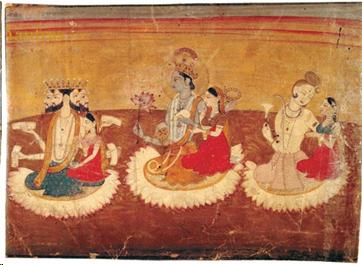
Introduction

Members of the Hindu pantheon, including Brahman and Vishnu
Welcome to our lecture on Hinduism and on the caste system, that is, on Ancient India's earliest organized religion and the social hierarchy based upon it, respectively. In this introductory section, I would like to highlight three things you should keep in mind regarding this lecture and its topic. First, Ancient India was the point of origin for two of the world's greatest religions: Hinduism and Buddhism. However, in this lecture, we concentrate solely on the former, Hinduism, which dates back to the age of the Aryan invasion of the Indian sub-continent ca. 1500 BCE. Hinduism is a blend of Aryan and Dravidian influences, and is both a religion and the basis for the continued social organization of India. Second, as a basic definition, I would like you to think of Hinduism as both a shared set of basic doctrines that Hindus all hold (although various variants may be found) and as a set of beliefs based upon the Vedas, hymns which I further discuss below. These doctrines were then expanded upon and explained in the Upanishads. Note that all Hindus agree that ultimate "Truth" lies in the precepts set forth in those hymns. Lastly, the history of ancient Hinduism can be divided into three main stages: the Vedic Period, the Classical Period, and the Medieval Period. However, in this lecture I only cover the first two, as it was during those first two periods that the character of Hinduism was crafted.